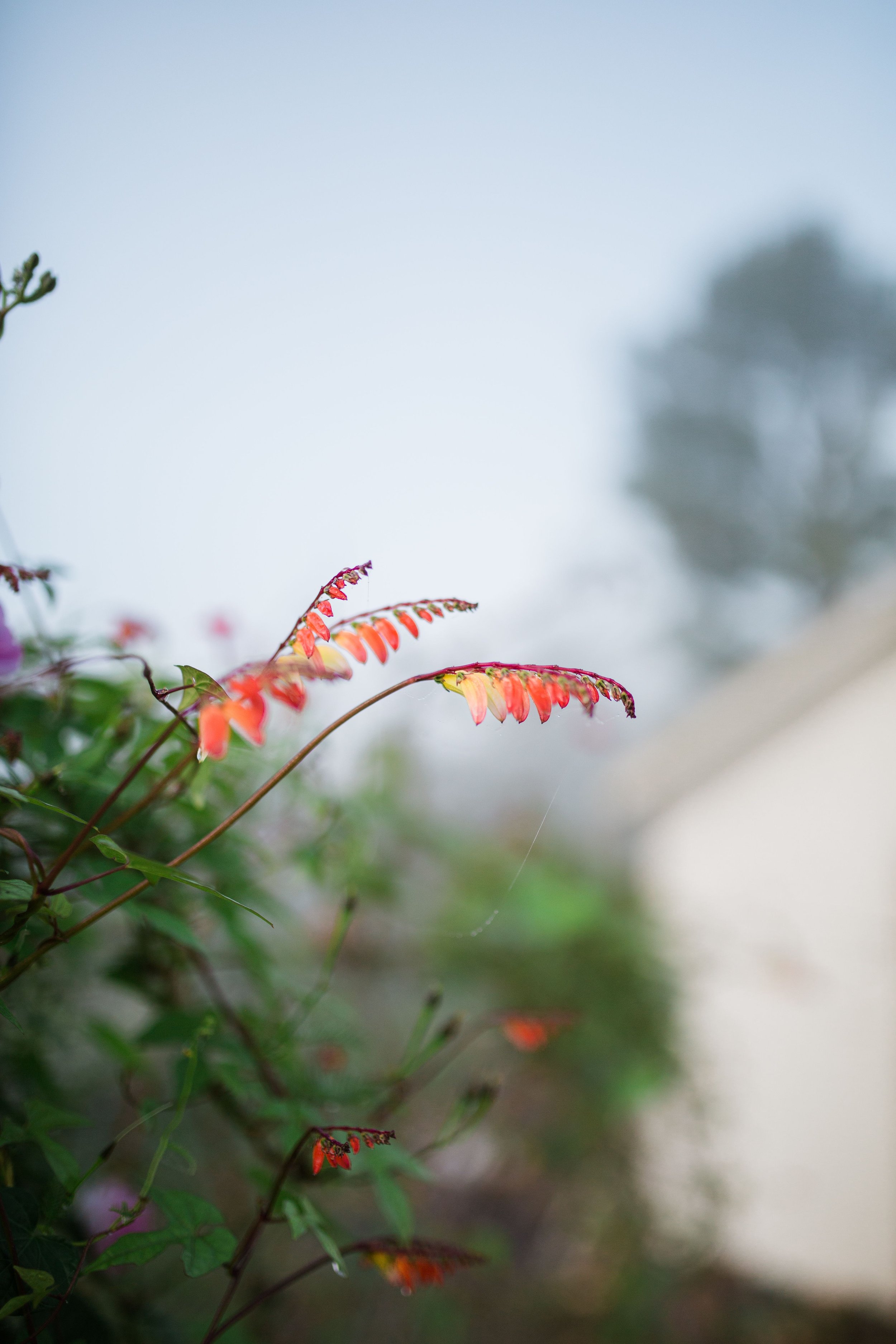Vines are one of the easiest ways to add height and interest to your growing space, and here in Virginia, thankfully there are many easy-to-grow varieties to choose from.
Whether you train them to run up a wall or railing, have them cover a trellis or archway, or allow them to lazily flow out of a window box, I highly recommend trying your hand at growing at least one if you haven’t already!
Below are my favorite go-to varieties for making the garden AND arrangements beautiful (and please refer back to the posts regarding where to source annuals and perennials if you’re looking for reliable companies from which to source them).
Annual Vines
Firecracker Vine (Mina lobata)
This gorgeous flowering vine is one that doesn’t have color until late summer, but the mini banana looking plumes that adorn its graceful green foliage starting in August is well worth the wait. It’s easy to grow in full sun, has shown itself to be mainly deer resistant, and has flowering stems long enough to put into mini bud vases.
Black Eyed Susan Vine (Thunbergia)
It may be a slow grower, but once Thunbergia takes off, it will reward you with blooms from early summer to first frost. These are offered in varieties of yellows and oranges, but my personal favorite is the less commonly seen white flower with black eye variety.
Planting tip: Start seeds indoors 6 to 8 weeks before last frost and transplant outdoors in late April to enjoy a longer bloom time.
Cypress Vine (Ipomoea quamoclit)
One of the easiest flowering vines to grow, this dainty vine is a hummingbird’s dream. It featuring daily fern like foliage and small tubular flowers in either red or white.
Moonflower
This one will blow you away with its giant white blooms that are at least the size of a human hand - sometimes even the size of your face! The magic of them is that blooms only open near sunset, so if you’re someone who isn’t home during the day, this is the vine that can be enjoyed in the evening as they glow beautifully in the moonlight (hence the name!).
Mexican Sour Gherkin (Melothria scabra)
Though this isn’t a flowering vine, this vine from the cucumber family is sure to add interest to your garden as well as arrangements. Also known as mouse melon (thanks to the fact that the fruit literally looks like tiny watermelons on the outside) it continually produces all season long if you continue to pick the fruit or cut pieces of the vine to put into vases. I personally find the fruit a bit bitter to eat right off the vine, but there are great recipes out there for ways to pickle it or enjoy it in cocktails!
Hyacinth Bean (Dolichos lablab)
Ruby Moon and Silver Moon Hyacinth Bean vines are two of the most prolific bloomers you can grow. Yes, they will turn into beans (which are edible if cooked thoroughly and consumed in small amounts), but personally I grow these for the flowers. They produce long slender stems topped with multiple blooms that look lovely in bud vases and arrangements! Unfortunately, these are not very deer resistant, but they will bounce back if they happen to be attacked once or twice in early to mid season. I know that from experience;)
Perennial Vines
Clematis
Clematis is a quintessential cottage garden vine given that its broad leaves and striking flowers add instant charm to a space. They grow beautifully without much help from you aside from training it to climb where you’d like, and they come back fuller every year without being so aggressive that they take over a huge space. It’s perfect for adorning mailboxes, light poles, and railings!
There are many colors and forms of this vine available, but when choosing which to grow, be sure to look at their bloom times. Some Clematis bloom mid spring, others mid summer, and a few in late summer. Getting a mix of all three will give you a constant full season blooming show!
Quick note: My personal favorite to plant for late summer is Clematis Virginiana, or Virgin’s Bower, as it is a beautiful white flower variety that is native to the eastern states. Please note that it has a non-native look alike, Clematis Paniculata, that can be aggressive and damaging to native plants - so please be sure to look carefully at the label when buying!
Passiflora (incarnata L.)
This exotic looking purple blooming vine is actually a native that you may have seen growing along the side of the road. The flowers are fragrant and bloom over several months, and this vine is quite the spreader (i.e. be sure you plant it where you want an abundance of vines for years to come!) It can handle trailing along the ground if you prefer to not trellis it, as pictured above.
Major Wheeler Coral Honeysuckle
This is a native honeysuckle that will grow abundantly yet not cause the harm that some non native honeysuckles can do. The tubular flowers typically bloom from April to June, and the foliage is wonderful to weave into arrangements all season long.
Trumpet Vine (Campsis radicans)
This vine is absolutely stunning and hummingbirds go mad for it! However, I have read that it can be a bit like English Ivy in that it has the potential to be intensely aggressive and has potential to cause structural damage if not maintained properly. Here’s a wonderful article outlining all you need to know about it before deciding if it’s right for you (or plant in a large pot if you want to avoid any potential harm!).
As always, happy growing! And please let me know if you have any questions.





